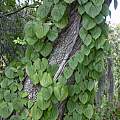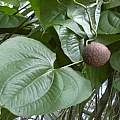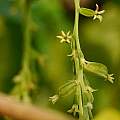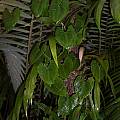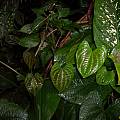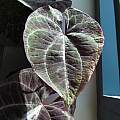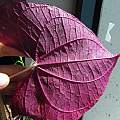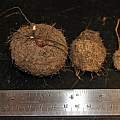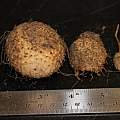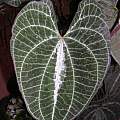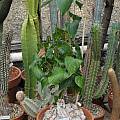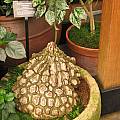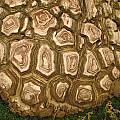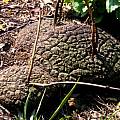Dioscorea is a large genus of more than 600 species in the Dioscoreaceae family. The genus has a world-wide distribution, many with tubers that are economically important (D. alata D. esculenta D. japonica, D. polystachya, etc.). They produce large (sometimes huge) tubers that can be situated below or above the soil. Some of the more commonly grown ornamental species have caudices, which brings into question if they could be considered a geophyte. We include those species here based on the criteria that we have set up on the What is a Bulb? page.
Dioscorea bulbifera is a perennial vine with broad, alternate leaves, and two types of storage organs. The plant forms bulbils in the leaf axils of the twining stems, and tubers beneath the ground. These tubers are like small, oblong potatoes, which explains its common name Air Potato. Named for Pedanios Dioscorides, 1st century Greek pharmacologist Source: Wikipedia. The bulbils can sprout even when tiny, causing this species to be considered a noxious weed with the potential to be invasive. Photos from the Wikimedia commons by Forest & Kim Starr (source) (source) (both shared under a CC BY 3.0 licence) and Dinesh Valke (source) (shared under a CC BY-SA 2.0 licence), respectively.
Dioscorea discolor is from Ecuador and Brazil and has nicely colored leaves. The tubers should be planted in a rich medium that is well drained. Give the plants part to full sun, depending on your location, and plenty of water as it is a thirsty tropical plant. Nhu Nguyen grows this plant on a sunny south facing windowsill. When the leaves have died down, drop watering and allow the tubers to dry out almost completely. When spring arrives, resume watering. Photos 1-2 taken by Tarcísio Eduardo Raduenz shows an almost completely green form. Photos 3-6 by Nhu Nguyen show a mottled leaf form, a beautiful magenta-red backside, the upper and lower portion of the tubers with distinctive warts found in the genus.
Photo by Johannes-Ulrich Urban shows leaf detail from a plant originating in Bolivia, Lowland Santa Cruz, cultivated under glass. It is a rewarding tuberous climber. The dormant tubers need some bottom heat to start (slowly) in spring.
Dioscorea elephantipes is a species native to the Cape Province of South Africa. The plant grows very slowly, can live for some 70 years and produce an above-ground tuber which may reach 1 meter tall. The tuber is covered by hard gray scales which protect the starchy interior. The species can withstand temperatures from 4 °C to 40 °C. The plant needs a dry summer dormancy, however they can be opportunistic growers and they decide on their own when they want to go into dormancy. Photo taken by Nhu Nguyen at the UC Botanical Garden.
Dioscorea mexicana (syn. Dioscorea macrostachya) is native to Mexico to Central America. This species seems to go dormant in winter (although this depends on individual specimens, some of which grow in winter in cultivation). The first photo shows a specimen at the UC Botanical Garden and the 2nd & 3rd shows a specimen at the Plant Conservatory, San Francisco, CA. Photos by Nhu Nguyen.
Dioscorea sylvatica var. paniculata bears massive, reticulated storage organs on the surface of the soil - the ones illustrated here average 400 mm in diameter. Vigorous, annual climbing stems can grow to as much as 4 or 5 metres in a season, however these can be trained quite comfortably around a wire hoop set in a pot when grown indoors. Male and female flowers are borne on separate plants. Photo and measurements by Rogan Roth.
